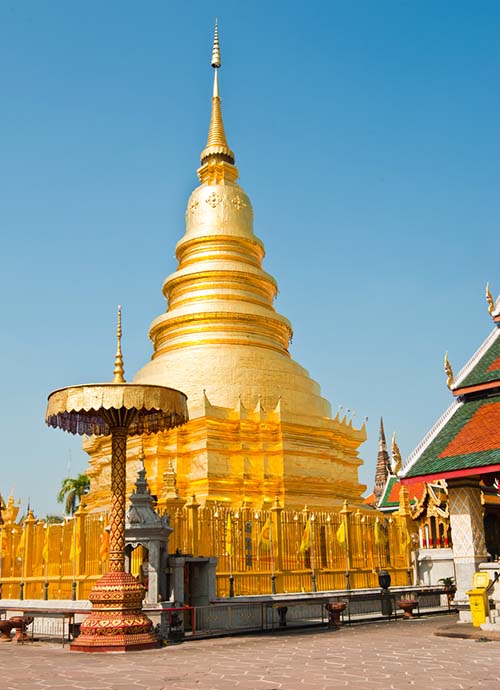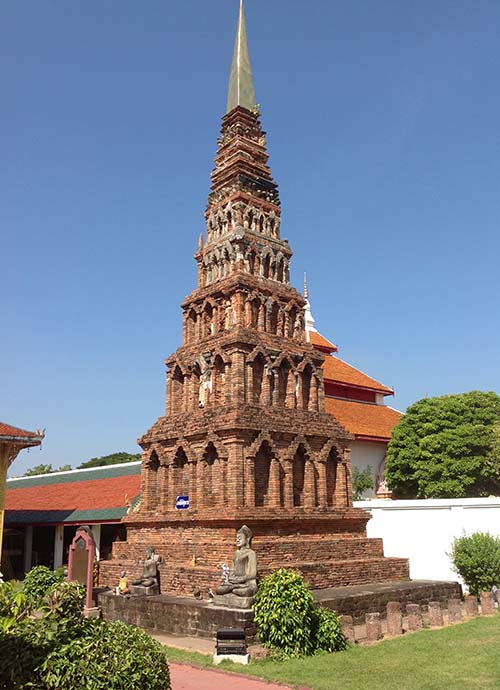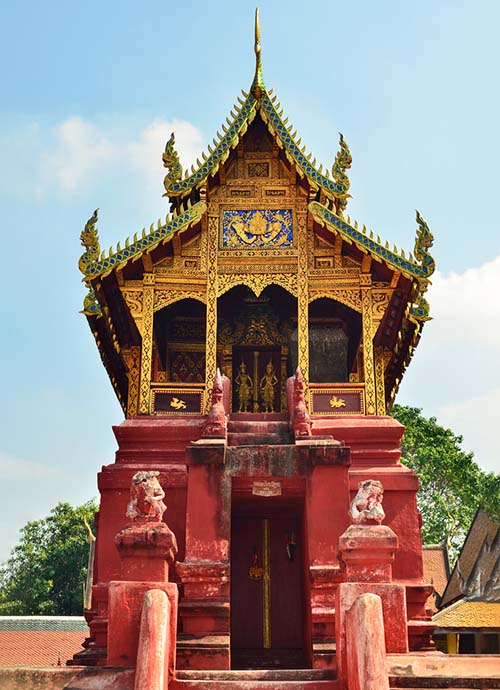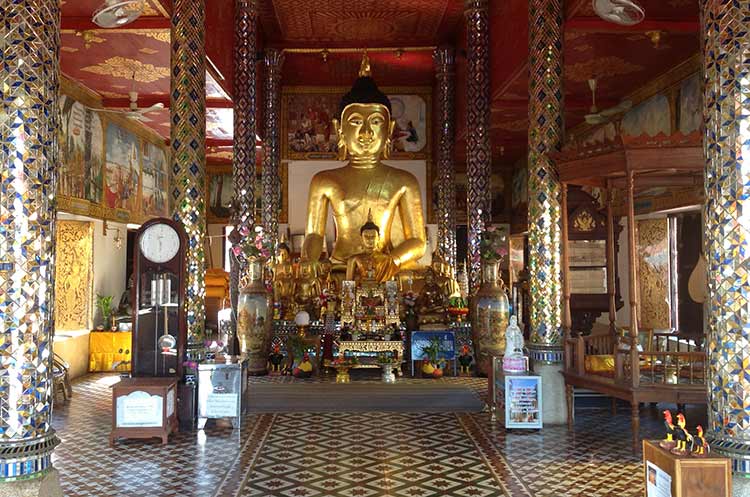
Wat Phra That Hariphunchai
12th Century Lanna temple with Mon style chedi
Lamphun
In the center of Lamphun town near the Mae Kuang river is the Wat Phra That Hariphunchai, a very large temple with numerous structures dating from different periods. The name of the Wat translates to “Temple of the Sacred Hariphunchai Relic”.
Lamphun is one of Thailand’s oldest cities. It was founded in the 9th century and was the capital of the Mon Kingdom Hariphunchai.
Mon architecture
The Lanna style Wat Phra That Hariphunchai was built on the site of an earlier 9th century Mon temple and houses one of the very few remaining examples of Mon architecture in Thailand.
Founded in 1150
According to legend, the temple was founded in 1150 by a Hariphunchai King, to enshrine a Buddha relic found in the palace garden. It was built on the spot where the palace of the first ruler of the Hariphunchai Kingdom, Queen Chamadevi used to be.
At the end of the 13th century, Hariphunchai was besieged by King Mengrai who brought Lamphun into the Lanna Kingdom. About mid 15th century, the temple was renovated and expanded with a number of Lanna style structures.
Structures of the temple
The grounds contain numerous structures, including several chedis. An arched entrance gate guarded by large red lions gives access to the square walled grounds.

Phra Maha That Chedi enshrining relics of the Buddha
The temple derives its name from the Phra Maha That Chedi, that was built to enshrine relics of the Buddha. The Lanna style chedi was built mid 15th century when Lamphun was part of the Lanna Kingdom. It is covered with copper plates and topped with a multi tiered golden umbrella weighing 6½ kilos. The 46 meter high chedi encases a much smaller 9th century Mon stupa. The chedi sits inside a square fenced space, not accessible to visitors. The gilded parasols at each of its four corners were added early 19th century.
The Mon style Suwanna chedi
A little older is the Mon style Suwanna chedi which dates from the early 15th century. It is one of the few remaining examples of Mon architecture in Thailand and similar in style to the chedi of nearby Wat Ku Kut. The Suwanna chedi has the shape of a stepped pyramid, with five steps of receding size. Originally, the brick stupa was covered with stucco, of which little is left. The chedi contains a total of 60 niches in which standing Buddha images were enshrined, most of which are missing today.
The Ho Trai or library
The temple’s Ho Trai, the building where the ancient Buddhist scriptures are kept, is a very elegant teak structure with a multi tiered roof and intricately carved doors. The Lanna style Ho Trai is built on top of a 3 meter high red painted stone base, which serves to protect the scriptures from flooding and insects.

Viharn Luang
The main viharn of the Wat Phra That Hariphunchai, the Viharn Luang was rebuilt in 1925. The very large structure has an impressive, very intricately decorated front façade and a multi tiered roof.
Inside the viharn that is adorned with beautiful lai kham decorations are several very old Buddha images, including a very highly revered image named the “Buddha with sharp shins”, a large seated Lanna style Buddha image cast in 1489.
Other viharns
The grounds of the Wat Phra That Hariphunchai houses an impressive number of viharns.
Next to the main chedi is the Viharn Phra Chao Lawo, a small structure with a multi tiered roof. Its front façade is beautifully decorated in gold and red colors.
The Viharn Phra Chao Daeng is a small viharn with a beautiful green and gold decorated pediment on its front façade. The viharn houses a large seated Buddha image in the Bhumisparsha mudra, surrounded by several smaller images. Behind it is another small viharn, named Viharn Phra Chao Pan Ton.
The Viharn Than Chai houses a standing Buddha image. Its murals were painted around five decades ago.
Other structures and the museum
Other structures on the grounds include the Buddha footprint chapel that contains multiple very large Buddha footprints, and an open red pavilion named Hor Rakhang that contains a bell and a large bronze gong.
A museum on the temple grounds exhibits a number of old Buddha images in several styles, including Mon and Lanna.

How to get to the Wat Phra That Hariphunchai
The temple is located in the center of Lamphun town, on the East end of Inthayongyot road (Highway 106), on the West bank of the Kuang river. The town of Lamphun is about 30 kilometers South of Chiang Mai, which takes around 30 minutes to reach by car.
Most hotels in Chiang Mai will be able to assist in booking a private taxi. Alternatively, charter a songthaew or catch a local bus from Chiang Mai to Lamphun, which takes around 1 hour and costs 20 Thai Baht. From downtown Lamphun, get there by samlor (three wheeled bicycle taxi) or tuk tuk.
Opening hours
The temple opens daily from 6 am until 6 pm.
The museum opens 6 days per week (closed on Mondays and Thai national holidays) from 9 am until 4 pm.
Since this is one of North Thailand’s most important temples, it can get very busy during weekends, Buddhist holidays and Thai national holidays.
Entrance fee
Admission charged at the ticket booth is (Thai Baht):